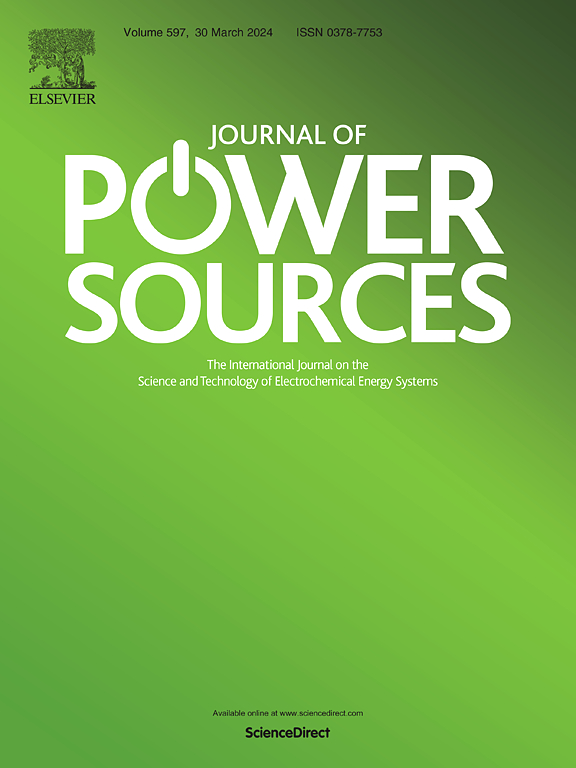战略性定制的CrCo2O4/MXene混合纳米架构:将Dunn模型的见解与卓越的离子电导率协同作用,实现高性能电池型可持续能源存储
IF 8.1
2区 工程技术
Q1 CHEMISTRY, PHYSICAL
引用次数: 0
摘要
全球对可持续技术的需求日益增长,促使研究人员开发具有优越属性的创新纳米材料,包括用于高效储能的高能量/功率密度。本研究首先采用水热法合成CrCo2O4 (CCO),然后采用溶剂热辅助法合成10 - 40% MXene/Ti3C2 (CCO-10, CCO-20, CCO-40)的复合材料。其中,CCO-40的比表面积为39.46 m2/g,孔体积为0.60 cm3/g。通过Dunn模型研究了其电化学行为。值得注意的是,在电流密度(J)为5.8 a /g时,恒流充放电显示CCO-40的比容量(Csc)为1009 C/g。此外,该电极在1470 W/kg功率密度下的能量密度(Ed)为70.0 Wh/kg,具有优异的循环稳定性,在3000次循环后保持97%的容量和98%的库仑效率。电化学阻抗谱分析表明,其离子电导率为7.8 × 10−4 S/cm,扩散系数为2.59 × 10−5 cm2/K。此外,组装的不对称器件在2.3 a /g下的Csc为383 C/g, Ed为74.64 Wh/kg, Pd为1674.05 W/kg。这些卓越的EC性能突出了CCO-40作为下一代能源解决方案的高效电极材料的潜力。本文章由计算机程序翻译,如有差异,请以英文原文为准。

Strategically tailored CrCo2O4/MXene hybrid nano-architectures: Synergizing Dunn Model's insights with superior ionic conductivity for high-performance battery-type sustainable energy storage
Increasing global demand for sustainable technologies has triggered the researchers to develop innovative nanomaterials with superior attributes, including high energy/power density for efficient energy storage. In this endeavor, a facile hydrothermal approach was employed to synthesize CrCo2O4 (CCO) and a subsequent solvothermal-assisted approach was used to form composites using 10–40 % MXene/Ti3C2 (CCO-10, CCO-20, CCO-40), respectively. Among these, CCO-40 demonstrated a surface area of 39.46 m2/g, and a pore volume of 0.60 cm3/g. The electrochemical (EC) behavior was investigated via Dunn's model. Notably, galvanostatic charge-discharge revealed an impressive specific capacity (Csc) of 1009 C/g for CCO-40 at a current density (J) of 5.8 A/g. Additionally, the electrode exhibited an energy density (Ed) of 70.0 Wh/kg at a power density (Pd) of 1470 W/kg, along with excellent cyclic stability, retaining 97 % capacity and 98 % coulombic efficiency after 3000 cycles. Electrochemical impedance spectroscopy showed a high ionic conductivity of 7.8 × 10−4 S/cm, and a diffusion coefficient of 2.59 × 10−5 cm2/K. Furthermore, the assembled asymmetric device demonstrated a Csc of 383 C/g with an Ed of 74.64 Wh/kg and a Pd of 1674.05 W/kg at 2.3 A/g. These outstanding EC properties highlight the potential of CCO-40 as a highly efficient electrode material for next-generation energy solutions.
求助全文
通过发布文献求助,成功后即可免费获取论文全文。
去求助
来源期刊

Journal of Power Sources
工程技术-电化学
CiteScore
16.40
自引率
6.50%
发文量
1249
审稿时长
36 days
期刊介绍:
The Journal of Power Sources is a publication catering to researchers and technologists interested in various aspects of the science, technology, and applications of electrochemical power sources. It covers original research and reviews on primary and secondary batteries, fuel cells, supercapacitors, and photo-electrochemical cells.
Topics considered include the research, development and applications of nanomaterials and novel componentry for these devices. Examples of applications of these electrochemical power sources include:
• Portable electronics
• Electric and Hybrid Electric Vehicles
• Uninterruptible Power Supply (UPS) systems
• Storage of renewable energy
• Satellites and deep space probes
• Boats and ships, drones and aircrafts
• Wearable energy storage systems
 求助内容:
求助内容: 应助结果提醒方式:
应助结果提醒方式:


